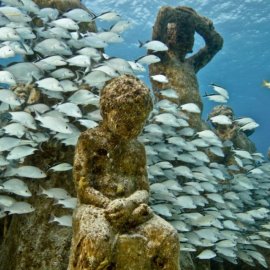The Sculptural Magnificence of Jason deCaires Taylor: Art, Affect, and Ocean
-
English
-
ListenPause
Welcome to World Ocean Radio… I’m Peter Neill, Director of the World Ocean Observatory. In a recent trip to New York City, I visited the new Whitney Museum of American Art, and specifically its Biennial, a review of what is purported to be the best in contemporary work by artists both established and emerging. Such exhibitions are meant to challenge, to provoke one’s ideas about content and technique. The selection was infuriating, not so much because of particular pieces that elicit controversy about race, violence, genocide, and other serious issues that characterize modern times, but because of the curatorial values implicit in the selection that seemed to me to be gratuitous, exploitative, often intellectually bankrupt, and depressing for all the wrong reasons. The experience did force me to question my own ideas about art, its purpose, and the criteria by which my personal response and appreciation is formed. For me, it comes down to “affect, not “effect,” an act to impress the mind or move feelings, more so than to produce a result or a pre-determined outcome. That said, let me provide an example of art that for me is so powerfully affecting, both aesthetically and as evocation of thought and feeling for the ocean, the threats to it by our unthinking endeavor, and the intellectual and emotional connection it has for psyche and civilization. I urge you to visit www.underwatersculpture.com to discover the work of Jason deCaires Taylor, the creator of underwater museums in which he installs sculptures of human figures on the ocean floor where current, wave, light, and marine organisms provide a constantly changing, dynamic patina of color and texture that speaks to the sacred and profane, to human folly and human joy, to the juxtaposition of natural forces that enable growth and decay just as they effect each of us in our transitory passage of life. These installations are unexpectedly and deeply humanistic and alive; each figure embodies a story not so different from ours, but dislocated by the conditions of an inundated place. The figures at Pompeii are similar – simple people caught in sudden moments by a natural disaster, a primeval force that is inevitable and incontrovertible and brooks no contradiction. Climate change, sea level rise, extreme weather, coastal erosion, tsunami, underwater volcanic eruption – these are the natural oceanic events of our time and no amount of hubris will protect our coasts. Hear Percy Shelley from his great poem Ozymandius: Half sunk a shattered visage lies, whose frown, And wrinkled lip, and sneer of cold command, Tell that its sculptor well those passions read Which yet survive, stamped on these lifeless things, The hand that mocked them, and the heart that fed; … There are no curators for this museum, no determining consciousness to tell us to think, or what to value. These works are unique and all affect. They impress upon our minds; they move our feelings; they are relentless. By their place and time they challenge and question every premise and perspective that inform life and community on land. By their poignancy and honesty, these works ask for our identity, empathy, and understanding. The ocean is at once a museum, a physical space where the ghosts of history swim with the fishes, as well a library with its collection of all species and its catalogue of all knowledge on which we will found and form our future. Please visit underwatersculpture.com. Admission is free, walk the galleries and stacks, think and feel, and act, and give thanks for art that is authentic and genuine and shows us the way. We will discuss these things, and more, in future editions of World Ocean Radio. - - - WORLD OCEAN RADIO IS PRODUCED BY THE WORLD OCEAN OBSERVATORY IN ASSOCIATION WITH WERU-FM, BLUE HILL, MAINE. WORLD OCEAN RADIO IS DISTRIBUTED BY THE PUBLIC RADIO EXCHANGE AND THE PACIFICA NETWORK. FIND OUR PODCAST ON ITUNES AND AT WORLD OCEAN OBSERVATORY DOT ORG.
In this week’s episode of World Ocean Radio we discuss the work of artist Jason deCaires Taylor, creator of underwater sculpture museums that explore the balance between society and nature and speak to how humans have affected the environment and our future place in it. His works, located in underwater museums offshore of Cancun and Spain, ask us to examine the transformations of nature and challenge our perspectives on life, community, identity, empathy, and understanding.
About World Ocean Radio
Peter Neill, Director of the World Ocean Observatory and host of World Ocean Radio, provides coverage of a broad spectrum of ocean issues from science and education to advocacy and exemplary projects. World Ocean Radio, a project of the World Ocean Observatory, is a weekly series of five-minute audio essays available for syndicated use at no cost by college and community radio stations worldwide. A selection of episodes is now available in Portuguese, Spanish, French, Swahili, and Mandarin, enabling us to reach 75% of the world's population. For more information, visit WorldOceanObservatory.org/world-ocean-radio-global.
Image
“Silent Evolution." Installation at MUSA (Museo Subacuático de Arte, Cancun, Isla Mujeres, Mexico.) The sculptural works of Jason deCaires Taylor serve as artificial reefs, providing habitat for fish and other ocean species. For more information visit his website, Facebook page, and follow him follow him @jason_decaires_taylor on Instagram.
Image Credit
Jason deCaires Taylor
Resources from this Episode
< Underwater Sculpture by Jason deCaires Taylor
< Percy Bysshe Shelley, Ozymandias
- Login to post comments



